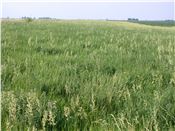Statewide Survey Of First-Generation European Corn Borer Confirms Exceedingly Low Population

European Corn borer action site.
URBANA, Ill.
A recent survey taken throughout the state by the University of Illinois Extension shows that the European corn borer population is down in Illinois.
The recent work is part of an ongoing U of I Extension integrated pest management program sponsored by the USDA National Institute for Food and Agriculture (NIFA).
The research team, led by Nick Tinsley, a crop sciences postdoctoral research associate, surveyed 28 counties between June 10 and June 22 for first-generation European corn borer injury.
Michael Gray, a U of I entomologist, explained that five cornfields were randomly selected in each county and, within each field, 100 consecutive whorl-stage plants were sampled for any signs of whorl feeding or the presence of European corn borer larvae. An action site was sampled for European corn borer moths near each field by making 100 sweeps with a standard insect sweep net.
“We characterized action sites as dense stands of tall grasses in roadside ditches or nearby waterways. Within these action sites moths congregate and mating occurs,” Gray said.
The counties and regions included in the sampling were: Bureau, Knox, Mercer, Ogle, and Whiteside (northwestern Illinois); Kane, Kankakee, LaSalle, Livingston, and McLean (northeastern Illinois); Adams, Fulton, Logan, McDonough, and Morgan (west central Illinois); Christian, Clark, Effingham, Piatt, and Vermilion (east central Illinois); Bond, Jackson, Macoupin, and St. Clair (southwestern Illinois); and Gallatin, Jefferson, Lawrence, and Massac (southeastern Illinois).
“Remarkably, no European corn borer moths were recovered at any of the 140 locations (5 fields in each of the 28 counties) in spite of making a total of 14,000 sweeps,” Gray said. “Of the 14,000 whorl-stage plants examined, only 68 had shot-holing or evidence of first-generation injury.”
The mean percentage of plants with first-generation whorl feeding by region was very low: 0.28 percent (east central); 0.56 percent (northeast); 0.64 percent (northwest); 0.75 percent (southwest); 0.25 percent (southeast); and 0.44 percent (west central).
“The extensive use of highly effective Bt hybrids and the area-wide suppression brought about by these transgenic hybrids is the primary explanation for these very low densities of European corn borers,” Gray said.
He explained that according to the USDA Economic Research Service (ERS), the use of “stacked gene varieties” accounted for 88 percent of the corn grown in Illinois during the current growing season. “The stormy weather pattern that enveloped much of Illinois during our sampling efforts also likely contributed to the poor establishment of the first generation of borers,” Gray added.
“During some of my summer meetings, a few producers mentioned they had discovered first-generation borers in their non-Bt cornfields. To some extent, this observation caught them by surprise. Although the overall European corn borer population is down across Illinois, this once-prominent insect pest flourished for decades (prior to the widespread adoption of Bt hybrids) in many cornfields each season across the Corn Belt,” Gray said.
“Where non-Bt corn is grown, European corn borers have the potential to infest these fields and cause losses. Therefore, don’t neglect to scout those fields carefully and be prepared to apply a timely rescue treatment,” he said.
Gray added that to date, there is no evidence of field-level resistance development by European corn borers to Bt hybrids.
“This is a remarkable success story nearly 20 years after the commercial release (1996) of Bt hybrids aimed at this insect,” Gray said. ∆